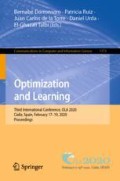Abstract
An accurate forecast of freight demand at sanitary facilities of ports is one of the key challeng-es for transport policymakers to better allocate resources and to improve planning operations. This paper proposes a combined hybrid approach to predict the short-term volume of containers passing through the sanitary facilities of a maritime port. The proposed methodology is based on a three-stage process. First, the time series is decomposed into similar smaller regions easier to predict using a self-organizing map (SOM) clustering. Then, a seasonal auto-regressive integrated moving averages (SARIMA) model is fitted to each cluster, obtaining predicted values and residuals of each cluster. A support vector regression (SVR) model is finally applied in each cluster using the historical data clustered and the predicted variables from the SARIMA step, testing different hybrid configurations. The experimental results demonstrated that the proposed model outperforms other methodologies based on SVR. The proposed model can be used as an automatic decision-making tool by seaport or airport management due to its capacity to plan resources in advance.
Access this chapter
Tax calculation will be finalised at checkout
Purchases are for personal use only
References
Babcock, M.W., Lu, X.: Forecasting inland waterway grain traffic. Transp. Res. Part E Logist. Transp. Rev. 38(1), 65–74 (2002). https://doi.org/10.1016/S1366-5545(01)00017-5. http://www.sciencedirect.com/science/article/pii/S1366554501000175
Box, G.E.P., Jenkins, G.M.: Time Series Analysis: Forecasting and Control. Holden-Day, Oakland CA (1976). Revised edn
Chen, H., Grant-Muller, S., Mussone, L., Montgomery, F.: A study of hybrid neural network approaches and the effects of missing data on traffic forecasting. Neural Comput. Appl. 10(3), 277–286 (2001)
Ismail, S., Shabri, A., Samsudin, R.: A hybrid model of self-organizing maps (SOM) and least square support vector machine (LSSVM) for time-series forecasting. Expert Syst. Appl. 38(8), 10574–10578 (2011). https://doi.org/10.1016/j.eswa.2011.02.107. http://www.sciencedirect.com/science/article/pii/S0957417411003137
Klein, A.: Forecasting the Antwerp maritime traffic flows using transformations and intervention models. J. Forecast. 15(5), 395–412 (1998)
Kohonen, T.: Self-Organising Maps. Springer, Berlin (1995). https://doi.org/10.1007/978-3-642-97610-0
Mak, K.L., Yang, D.H.: Forecasting Hong Kong’s container throughput with approximate least squares support vector machines. In: Proceedings of the World Congress on Engineering, vol. 1, pp. 7–12. Citeseer (2007)
Moscoso-López, J.A., Turias, I., Jiménez-Come, M.J., Ruiz-Aguilar, J.J., Cerbán, M.D.M.: A two-stage forecasting approach for short-term intermodal freight prediction. Int. Trans. Oper. Res. (2016). https://doi.org/10.1111/itor.12337
Ruiz-Aguilar, J.J., Turias, I., Moscoso-López, J.A., Jiménez-Come, M.J., Cerbán, M.: Forecasting of short-term flow freight congestion: a study case of Algeciras Bay Port (Spain). Dyna 83(195), 163–172 (2016). https://doi.org/10.15446/dyna.v83n195.47027. http://www.revistas.unal.edu.co/index.php/dyna/article/view/47027
Vapnik, V.N.: Statistical Learning Theory. Wiley, New York (1998)
Xie, G., Wang, S., Zhao, Y., Lai, K.K.: Hybrid approaches based on LSSVR model for container throughput forecasting: a comparative study. Appl. Soft Comput. https://doi.org/10.1016/j.asoc.2013.02.002, http://www.sciencedirect.com/science/article/pii/S156849461300046X
Acknowlegements
Authors acknowledge support through grant RTI2018-098160-B-I00 from MINECO-SPAIN. The database has been kindly provided by the Port Authority of Algeciras Bay.
Author information
Authors and Affiliations
Corresponding author
Editor information
Editors and Affiliations
Rights and permissions
Copyright information
© 2020 Springer Nature Switzerland AG
About this paper
Cite this paper
Ruiz-Aguilar, J.J., Urda, D., Moscoso-López, J.A., González-Enrique, J., Turias, I.J. (2020). Container Demand Forecasting at Border Posts of Ports: A Hybrid SARIMA-SOM-SVR Approach. In: Dorronsoro, B., Ruiz, P., de la Torre, J., Urda, D., Talbi, EG. (eds) Optimization and Learning. OLA 2020. Communications in Computer and Information Science, vol 1173. Springer, Cham. https://doi.org/10.1007/978-3-030-41913-4_7
Download citation
DOI: https://doi.org/10.1007/978-3-030-41913-4_7
Published:
Publisher Name: Springer, Cham
Print ISBN: 978-3-030-41912-7
Online ISBN: 978-3-030-41913-4
eBook Packages: Computer ScienceComputer Science (R0)

